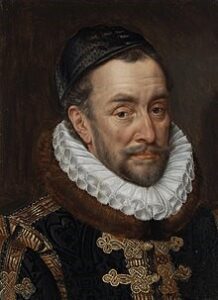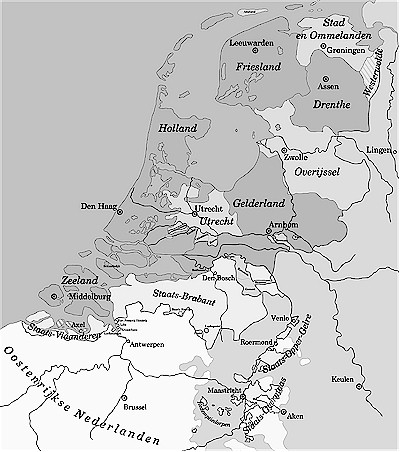In the latter part of the 16th century the political climate in the Dutch republic was very supportive of the Huguenot cause. This appeared to have been a well known fact in France and the likely reason that the Dutch Republic received the largest group of Huguenot refugees with an estimated 75,000 to 100,000 Huguenots after the revocation of the Edict in 1685. Amongst them were as many as 200 reverends.

William of Orange (1544-1584)
In 1581 William of Orange, count of Nassau – also nick-named “William the Silent”- the stadtholder (governor) of the provinces of Holland, Zeeland and Utrecht, led a rebellion that resulted in the country’s seven most Northern provinces’ seceding from the King of Spain. Earlier, in 1544, when he was only 11 years of age, he had inherited the Principality of Orange in Southern France. The Principality was incorporated into the holdings of what became the House of Orange. This pitched it into the Protestant side in the French Wars of Religion and as an independent enclave within France, Orange became an attractive destination for Protestants and a Huguenot stronghold.
William married four times. In 1583 he married Louise de Coligny (1555 –1620). She was the daughter of Gaspard II de Coligny who was murdered at the St. Bartholomew’s Day massacre in France, together with her first husband Charles de Téligny (1571). Like her father, she was a French Huguenot and remained an advocate for Protestantism until her death in 1620. Their union would be short lived, however. Declared an outlaw by the Spanish king in 1580, William was assassinated by Balthasar Gérard in Delft in 1584.
These early ties between Huguenots and the Dutch Republic’s military and political leadership – the House of Orange-Nassau – since the start of the Dutch Revolt explains the many early settlements of Huguenots in the Dutch Republic’s colonies around Cape of Good Hope in South-Africa and the New Netherlands colony in America.
Stadtholder William III of Orange (1650-1702), a great-grandson of William the Silent – and who in 1689 became King of England, Scotland and Ireland when he married to Mary II, Queen of Scotland – emerged as the strongest opponent of Louis XIV, after Louis’ attack on the Dutch Republic in 1672. He formed the League of Augsburg as main opposition coalition. Consequently many Huguenots saw the wealthy and calvinist Dutch Republic, leading the opposition against Louis XIV, as the most attractive country for exile after the revocation of the Edict of Nantes. They also established many more French speaking calvinist churches there.
Following the Declaration of Independence the republic continued to flourish. Also called the Republic of the United Netherlands, it acquired great political and economic power in the 17th century. The country became known for the flourishing arts and sciences as well as for that time relatively great spiritual freedom. It played a major role on the world stage for some time and ended with the French invasion of 1792-1795 and the subsequent creation of the Batavian Republic (1795–1806).

Dutch Republic in 1583
Remarkable for a small republic of around 1.5 million inhabitants were the great military successes as compared to much stronger countries such as Spain and England and especially the success of its world trade. Facilitated by its huge fleet of as many as 2000 ships – larger than that of England and France combined – it traded with neighbouring countries around the Baltic Sea as a member of the Hansiatic League as well as at the other side of the world through the West India Company (WIC), and especially through the Dutch East India Company or VOC.
Established in 1602, with its pioneering institutional innovations and powerful roles in global business history, the VOC is often considered by many to be the forerunner of modern corporations. It was their 17th century institutional innovations and business practices that laid the foundations for the rise of giant global corporations in subsequent centuries. The Amsterdam Stock Exchange was established in 1602 by the VOC for dealings in its printed stocks and bonds. It was subsequently renamed the Amsterdam Bourse and was the first to formally begin trading in securities.

The Courtyard at the Amsterdam Stock Exchange
Amsterdam and the area of West-Frisia were the first areas providing full citizens rights to Huguenots in 1705, followed by the entire Dutch Republic in 1715. Huguenots married with Dutch from the outset. Many Huguenot descendents in the Netherlands today are recognisable by their French family surnames. Due to their early ties with the Dutch Revolt’s leadership and even participation in the revolt, parts of the Dutch patriciate are of Huguenot descent. After 1815, when the Netherlands became a monarchy under the House of Orange-Nassau, some Huguenot patriciate families have been provided with an aristocratic predicate, such as Jhr. (Jonkheer).
